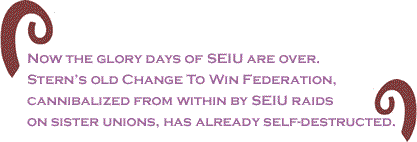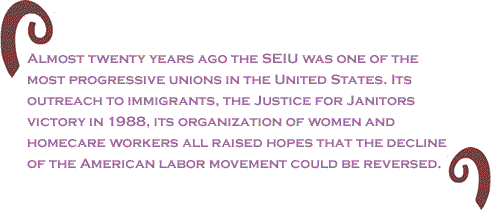The
Civil Wars in U.S. Labor: Birth of a New Workers' Movement
or Death Throes of the Old? by Steve Early (Haymarket Books, 2011)
by Steve Early (Haymarket Books, 2011)
In
classical drama, tragedy is the story of a noble hero whose
fall, whose ultimate ruin, flows from a tragic flaw of character�extreme
pride, excessive ambition, lust for power�the flouting of
natural limits imposed by the gods of justice.
Steve
Early�s riveting history of the second-largest labor union
in the U.S.�the rise and decline of SEIU (Service Employees
International Union)�has the feel of tragedy. It�s a cautionary
tale about SEIU�s fatal flaw: centralization of union power
by any means necessary.
Almost
twenty years ago the SEIU was one of the most progressive
unions in the United States. Its outreach to immigrants,
the Justice for Janitors victory in 1988, its organization
of women and homecare workers all raised hopes that the
decline of the American labor movement could be reversed.
The
150,000-member United Healthcare Workers West, led by Sal
Rosselli, former president of Local 250, played a pioneering
role in the ascendancy of SEIU. The historic, �gold-standard�
contract with Kaiser in 2005, crafted by the same negotiators
who lead NUHW (National Union of Healthcare Workers) today,
bolstered SEIU�s power and prestige. One hundred and fifty
local activist members participated directly in the 2005
contract negotiations.
Now
the glory days of SEIU are over. Stern�s old Change To Win
Federation, cannibalized from within by SEIU raids on sister
unions, has already self-destructed. SEIU is no longer the
same international union in which so many workers placed
their hopes some years ago. SEIU today is the most hated,
the most divisive labor organization in the U.S. No union
in recent times raised hopes so high, and no union has sunk
so low.
To
what end, for whose benefit, and by what means, did SEIU
turn a member-active international union into a corporate
hierarchy, dominated by lawyers, $230,000-a-year executives,
consultants, 1-800 remote call-centers, and well-paid staff
who now manage the workforce? And how did SEIU leaders�not
only Stern, but Mary Kay Henry and her own sidekick, the
hate-preaching Dave Regan�alter the internal relationships
of power so swiftly and dramatically? And with such impunity.
These are the kinds of questions that Early addresses in
CIVIL WARS IN U.S. LABOR.

Early
is a participatory journalist who�s handled contract grievances,
trained shop stewards, recruited youth to the labor movement,
led strikes and boycotts. He is not only an experienced
organizer, he is a polished writer with a knowledge of labor
history, as well as the history of politics and war. No
writer is in a better position to survey the rise and fall
of SEIU.
Early�s
chronicle is based on meticulous research: direct observation
at worksites, published and unpublished documents, interviews
with rank-and-file activists, with key players like California
Nurses Association�s Rose Ann Demoro and UNITE HERE�s John
Wilhelm. Early also draws on the best contemporary pro-labor,
pro-democracy writing: POOR WORKERS' UNIONS, by Vanessa
Tait, and BEYOND THE FIELDS, by Randy Shaw.
REFORM
BY TRUSTEESHIP
Trusteeship�or
rather, the abuse of trusteeship power�is the key to understanding
the moral and structural degeneration of SEIU.
Trusteeship
is a form of martial law. In so far as trusteeship is legal,
trusteeship is an exceptional event under exceptional circumstances.
At best, it is an extraordinary measure designed to rescue
members of a local union from corrupt or inept officials.
Any takeover of a union that removes hundreds of elected
leaders and thousands of stewards is not a legal trusteeship;
it�s a purge, a coup.
In
the 1950s the United Mine Workers carried out open-ended
trusteeships that produced disastrous consequences for the
coal miners. In the aftermath of political trusteeships,
contract negotiations were conducted in secret. Sweetheart
contracts were signed. Working conditions deteriorated.
Black Lung disease spread. The end of member control in
the UMW, Early reminds us, �led to a dark descent
into the worst sort of union racketeering�.�
Jimmy
Hoffa�s mob-run Teamsters also used trusteeship as a way
of rewarding political allies and punishing rank-and-file
activism. In the history of American labor, trusteeships
are more often a cause of corruption than a remedy for wrongs
in local affairs.

80
TAKEOVERS
No
labor union in modern history has employed trusteeship so
ruthlessly and systematically as SEIU. A pamphlet by the
California Nurses Association is entitled: �Andy Stern�s
Playbook for Conquest. Hostile Takeovers of Unions and Workers.�
According
to Vanessa Tait in POOR WORKERS� UNIONS, published
in 2005, fourteen percent of SEIU affiliates were under
trusteeship at that time. Some 40 locals were already �forced
into trusteeships with officers newly appointed by the national
union, usually from outside the units they handled.� In
the same period, Stern also engineered 136 forced mergers.
Locals were dismembered. Experienced organizers (like Paul
Krehbiel of Local 660) were fired. Shop steward networks
were replaced by Call Centers.
The
systematic destruction of democratic infrastructures of
SEIU, the product of years of organizing and struggle, spawned
a culture of resignation, conformity and fear.
Between
2005 and 2010, the number of takeovers doubled. According
to Early�s account, by 2010 Stern had put more than 80 local
unions under trusteeship or forced mergers. No period in
history matches the scale and scope of SEIU�s serial takeovers.
Juan Gonzalez, columnist for the New York Daily News,
captured the meaning of the trusteeship campaign when he
called SEIU �the Roman Empire of the labor movement.�
CANADA
SEIU
trusteeships are part of a longterm agenda to corporatize
the union�by command, by force, and fiat. Each trusteeship
is planned long before SEIU manufactures a scandal, some
pretext for a takeover. Notwithstanding a master plan, when
the actual takeovers take place in specific jurisdictions,
they are marketed to the local victims as rescue operations.
In
2000, SEIU trusteed virtually the entire province of Ontario,
Canada. SEIU attempted to merge eight local unions, only
to provoke an exodus from SEIU. In order to void a membership
vote against involuntary mergers, SEIU trusteed six locals.
Trusteeship was a pre-emptive strike, though no weapons
of union destruction were ever discovered. The Ontario tornado
manifests a pattern. Forced mergers drive members to resist.
Trusteeship is imposed. All staff lose their jobs�their
livelihoods. Executive committees are dismantled. Then unscrupulous
law firms launch punitive lawsuits. SEIU filed a $3.7 million
lawsuit against Ken Brown, former vice-president of the
Canadian local. Since SEIU locals have no rights which the
International is bound to respect (under the present constitution),
elected officers who oppose mergers can be sued.
Local
87 in San Francisco faced the same fate as Canadian locals.
Contrary to their express wishes, Local 87 members were
forced to merge with Local 1877. When the International
placed 87 in trusteeship, all staff were dismissed, the
elected president removed as well. In the aftermath of the
takeover, �workers ended up with health care givebacks in
a local unwilling to fight layoffs,� writes Early.
Early
quotes Monty Kroopkin on the disappointing effects of SEIU
forced mergers in San Diego: �The 2007 mergers resulted
(for us) in not only no elected leadership, but a culture
of no accountability, grossly overpaid senior staff, a severe
reduction in the amount of information members got about
anything; weak-to-nonexistent enforcement of our contracts;
a steady decline in our membership numbers; loss of two
bargaining units to decertification and independent unions...�
TRUSTEESHIPS
BREED CORRUPTION
Steve
Early is not a muckraker. His approach to SEIU is sociological,
focused on the structures of power. According to Early,
excessive power and corruption are twins. The recent corruption
scandals in SEIU are not mere accidents of time and place.
Corruption is an inherent feature of business unionism by
trusteeship.

Long
before the Los Angeles Times, in Paul Pringle�s 2008
award-winning series, disclosed rampant corruption in SEIU
(in the very locals under trusteeship), Steve Early himself,
in 2004, warned the labor movement about the potential for
SEIU scandals. The forced mergers and purges, the trusteeships
were omens. While many pro-labor academics were still in
awe of Stern�s audacity, Early called attention to the SEIU
patronage, where loyalists and suck-ups are rewarded with
�consulting fees,� where trustees and outsiders spend other
people�s money without transparency or accountability. Early
predicted that abuse of trusteeship powers would �come back
to haunt the union.� �Corruption scandals will erupt sooner
or later,� he wrote. Sooner as it turned out.
The
scandals broke. Byron Hobbes, the executive vice president
who billed his local for $9,000 in personal expenses; Tyrone
Freeman, the much-coddled president of the largest local
in the U.S., found guilty of embezzlement; Rickman Jackson,
head of Michigan�s largest local (and Dave Regan�s co-organizer
of the �brown shirt� disruption of a Labor Notes conference),
mired in lease-payment scandals; Annelle Grajeda, who used
her influence to put her ex-boyfriend on a county payroll;
Garold Lawson, who grabbed more than $70,000 from a small
union with 200 members�the list of criminals and double-dippers
goes on.
Far
from cleaning out improprieties within local jurisdictions,
the Stern and Henry trusteeships actually infused corruption
and malfeasance into locals that were once healthy and democratic.
Corruption grew like mushrooms in the dark. The trusteeship
campaigns essentially dismantled the frail safeguards by
which rank-and-file members protect their rights, their
dues and treasury, the very integrity of union life.
THE
RESISTANCE
No
one writes more convincingly about the power and hope of
union democracy than Steve Early. CIVIL WARS IN U.S.
LABOR is not only a comprehensive history of the rise
and degeneration of a once-progressive union, it�s also
a story of the resistance�the democracy movement within
SEIU and the insurgency of the National Union of Healthcare
Workers�the same activists who built UHW, until they were
trusteed in 2009.
The
resistance first appeared a few years ago as a challenge
to the openly anti-democratic ideology of Andy Stern. Stern
rewrote the SEIU constitution, depriving local members of
control over their own contract negotiations.
 Stern
was not especially subtle about SEIU aims to remake the
union along corporate lines. He mocked the defenders of
democratic unionism, and he called membership-run locals
impediments to change. Stern
was not especially subtle about SEIU aims to remake the
union along corporate lines. He mocked the defenders of
democratic unionism, and he called membership-run locals
impediments to change.
In
a series of interviews, he claimed that workers don�t really
care about abstract democracy. �Our members are more concerned
about being serviced.� �It�s hard to make the argument that
unions with direct elections better represent their members.�
In
The Wall Street Journal, Stern called for
�a new model of unionism less focused on individual grievances,
more focused on industry needs.�
Stern
often used caricature to express his contempt for membership-run
unions. He called Local 29 an �anachronism.� �Leaders who
stand in the way of change, screaming democracy...just don�t
get it.� For workers �who just don�t get it,� he advocated
the �persuasion of power.� Ergo trusteeship, the use of
police against dissidents, the use of espionage against
union members, vigilante violence, punitive lawsuits against
elected union officers who stand with the members.
Lies
are halfway around the world before truth gets out of bed.
And many SEIU locals were already dismembered when committees
of correspondence began to form. Pro-democracy activists
throughout the country�the very organizers who devoted years
of their lives building steward councils, safeguards against
layoffs, local power�slowly began to challenge the totalitarian
visions of Stern, Berger, and Henry.
Sal
Rosselli is the most passionate, the most articulate defender
of grassroots power in the labor movement. For Rosselli,
democracy is not (as Stern�s caricature implied) some moral
abstraction; it�s the lifeblood of a union, the primary
means by which labor empowers itself, secures and enforces
decent contracts.
Every
major victory in labor history, from the right to organize,
to the eight-hour day, was achieved through mobilization
of the rank and file. Centralization of power, seductive
as it seems to college-educated reformers who seek quick
results through top-down commands, is fatal to union vitality
and health.
While
others in the labor movement slept, NUHW took a stand. As
Amy Ryan, a Kaiser worker, put it in her testimony during
the trial of the NUHW-16: �We knew SEIU was coming, and
we wanted to be there to make our stand and let them know
that the members don�t want them to destroy the union that
was the citadel of our hopes and dreams.�

In
a fitting conclusion to his definitive work, Early writes:
�One can only hope that the creativity, tenacity, and courage
of the California health care workers�who stuck to their
guns when the political artillery of others fell silent�points
the way toward a better model of worker organization. Until
there is a broader rank-and-file militancy, the NUHW struggle
will remain an inspiring example and necessary experiment
in independent unionism in a situation where the road to
internal union reform was hopelessly blocked. Sustaining
a fledgling labor organization, with few resources but a
resilient rank-and-file, has not been�and will not be�easy.
The path taken by NUHW members was born of internal union
strife occurring at a bad time for union organizing in general.
It was not a path freely chosen.�
And
to this I humbly add: History will vindicate Sal Rosselli,
the leaders of NUHW, and thousands of activists who, at
great cost to themselves, in face harassment and intimidation,
took a stand in defense of the right of workers to control
their own destiny.
BlackCommentator.com Guest
Commentator, Paul Rockwell, is a writer living in the Bay
Area. He is also a columnist for In Motion
Magazine. Click here to reach Mr. Rockwell.
|

